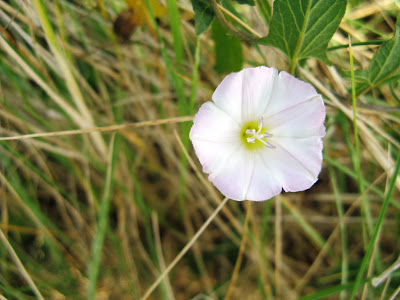





















 There seem to be a lot of wild flowers still in bloom as one jogs (slowly) from the University to Westcross. They include Sea bindweed (Calystegia soldanella); Hedge bindweed (Calystegia sepium); Dandelion (Taraxacum spp); Lesser hawkbit (Leontodon saxatilis); Common ragwort (Senecio jacobaea); Sea mayweed (Tripleurospermum maritimum); Daisy (Bellis perennis); Bastard cabbage (Rapistrum rugosum); Annual wall rocket (Diplotaxis muralis); Sea holly (Eryngium maritimum); Large-flowered evening primrose (Oenothera glazoviana); Rosemary (Rosmarinus officinalis); Rock samphire (Crithmum maritimum); White clover (Trifolium repens); Red clover (Trifolium pratense); Ivy-leaved toadflax (Cymbalaria muralis); Sea plantain (Plantago maritima); Bramble (Rubus fruticosa); Yarrow (Achillea millefolium); Soapwort (Saponaria officinalis); Sunspurge (Euphorbia helioscopia) and Groundsel (Senecio vulgaris). Bumble bees (Bombus terrestris) continued to bounce from flower to flower.
There seem to be a lot of wild flowers still in bloom as one jogs (slowly) from the University to Westcross. They include Sea bindweed (Calystegia soldanella); Hedge bindweed (Calystegia sepium); Dandelion (Taraxacum spp); Lesser hawkbit (Leontodon saxatilis); Common ragwort (Senecio jacobaea); Sea mayweed (Tripleurospermum maritimum); Daisy (Bellis perennis); Bastard cabbage (Rapistrum rugosum); Annual wall rocket (Diplotaxis muralis); Sea holly (Eryngium maritimum); Large-flowered evening primrose (Oenothera glazoviana); Rosemary (Rosmarinus officinalis); Rock samphire (Crithmum maritimum); White clover (Trifolium repens); Red clover (Trifolium pratense); Ivy-leaved toadflax (Cymbalaria muralis); Sea plantain (Plantago maritima); Bramble (Rubus fruticosa); Yarrow (Achillea millefolium); Soapwort (Saponaria officinalis); Sunspurge (Euphorbia helioscopia) and Groundsel (Senecio vulgaris). Bumble bees (Bombus terrestris) continued to bounce from flower to flower.
%20mating%20NWCW.jpg)


No comments:
Post a Comment